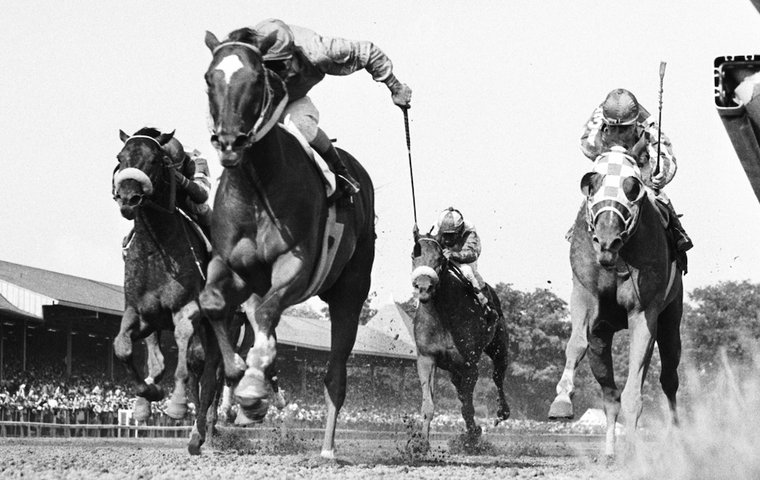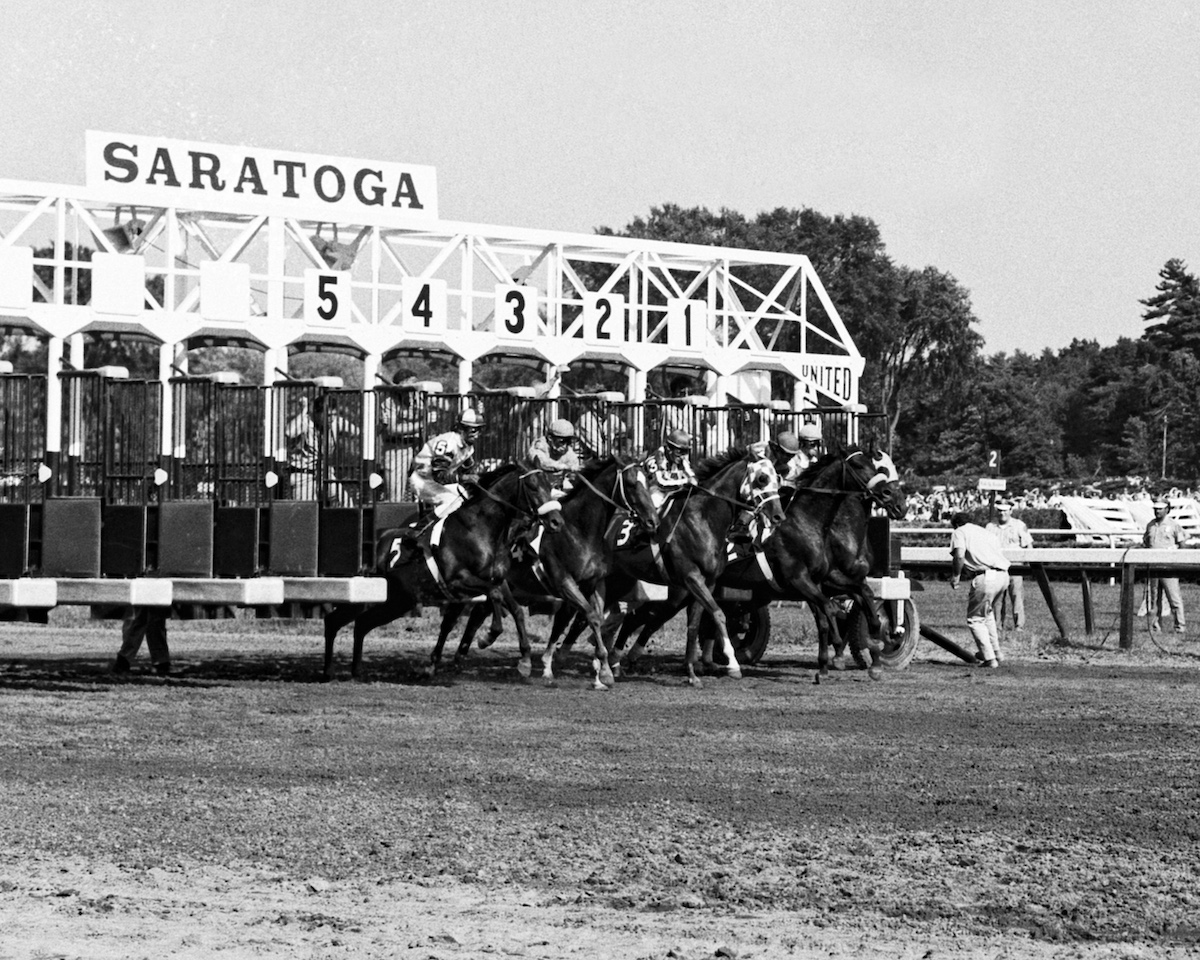
On the 50th anniversary of the 1973 Saratoga meet, Carly Silver looks back at the season when America’s most beloved racecourse cemented its reputation for surprise results
USA: Not for nothing is Saratoga known as the Graveyard of Champions. The list of those to have been stunned at the Spa reads like a who’s who of US racing, with the likes of Man o’War, Gallant Fox and American Pharoah among those to have bitten the dust.
It was the 1973 meet, however, that did much to cement such a notorious reputation via a series of surprise results – headed by a shock defeat for the greatest Triple Crown winner of them all.
After Secretariat’s astonishing 31-length victory in the Belmont Stakes, everyone expected the Whitney Stakes to be little more than another lap of honor for the equine nonpareil. But the specters of Jim Dandy and Upset were hungry for the agony of defeat, and the Graveyard of Champions would claim more victims before summer was out.

In 1973, renowned racing journalist Steve Haskin was just beginning his decades-long career as a writer, still holding down a day job as the Daily Racing Form librarian. He recalled the atmosphere of anticipation gilding the Spa that summer when Saratoga was expecting record attendance for Secretariat’s run in the Whitney.
“NYRA did something they had never done before,” said Haskin, who currently writes the excellent Askin’ Haskin blog at secretariat.com. “They opened the infield and they had the horses saddled on the grass course,” added Haskin.
“So they had never done that. And they just felt, look, if Secretariat was 80%, he could still beat these horses. And they decided well, we'll run him. But he was sick a week before leading up to it.”
Shock outcome
Secretariat was a 1-10 shot in a five-runner field for what was then a G2 event. The powers-that-be figured that even on a bad day, Secretariat would be good enough to beat the best of the rest on their good day. But any such glib theory was soundly disproven with a shock outcome that has gone down in racing folklore as 12-1 outsider Onion beat Secretariat by a length.
The winner’s trainer H. Allen Jerkens was to repeat the dose a few weeks later when he saddled Onion’s stablemate Prove Out to beat Secretariat in the G1 Woodward to earn himself the nickname ‘Giant Killer’ – which, to be fair, the trainer loathed.
Onion’s defeat of Secretariat put a spanner in the works for other reasons as well. Prior to the Whitney, the cigarette brand Philip Morris had planned to sponsor a $250,000 match race at Belmont in September between Secretariat and his year-older stablemate Riva Ridge, who had won the Kentucky Derby and Belmont Stakes in 1972.
“Riva Ridge had just broken the world record winning the Brooklyn Handicap,” explained Haskin, “and he equaled a track record in the Massachusetts Handicap. So he was on a roll – he was the leading older horse in the country.”
Now, with Secretariat’s defeat, this Marlboro Cup was up in the air – the chestnut colt wasn’t going to make the Travers Stakes, never mind the match race.
Moroever, Riva Ridge also wasn’t playing his role to best effect either; not at Saratoga, anyway.
Because Secretariat was entered in the Whitney, trainer Lucien Laurin aimed Riva Ridge elsewhere. “So a few days after the meet started, or very close to the beginning of the meet, for some strange reason, Lucien Laurin was looking for any kind of race to run Riva Ridge in,” Haskin explained. “And he wound up running him in a mile-and-a-sixteenth allowance race on the grass!”
Startling development
Despite going off as the 1-2 favorite, the lanky bay was bested by a 56-1 shot named Wichita Oil. The New York Times’ Joe Nichols quipped that “Riva Ridge's failure was the most startling development on a day of big doings,” otherwise highlighted by 5,000 watching Secretariat work that morning.
As secretariat.com notes: “After both were beaten in the same week by unknowns, one wag suggested the Marlboro match race should pit Onion versus Wichita Oil.”
The Philip Morris execs must have felt a frisson of discomfort. “So now they have to say, ‘Well, what are we going to do now?” reflected Haskin.
“Secretariat gets beat in the Whitney and he's sick and he's going to miss the Travers because he was that sick. So they said, ‘Well, we've got to change the whole format of the Marlboro Cup.’”
Thus what was designed as the marquee event of the fall morphed from a match race into an invitational, featuring the best horses from across North America.
Meanwhile, Riva Ridge continued to fumble as he returned in another low-grade event – another Saratoga allowance 20 days later. At least this one was back on dirt.
Barely hung on
“So they ran him there saying, ‘Oh, let’s him get back in the winning column,’” said Haskin. “He did win, but he opened up a big lead in the stretch and he barely held off Halo.
“Halo came flying. I think Riva Ridge had a four-length lead at the eighth pole and he wound up winning by a half a length. He just barely hung on. And I said, ‘Oh, God. There was just nothing about Riva Ridge anymore.’”
 Meadow Stables’ two stars had both had their halos tarnished by events at Saratoga and with Secretariat not running in the Travers, the field loaded up with eager hopefuls looking to annex the storied contest known colloquially as the ‘midsummer derby’.
Meadow Stables’ two stars had both had their halos tarnished by events at Saratoga and with Secretariat not running in the Travers, the field loaded up with eager hopefuls looking to annex the storied contest known colloquially as the ‘midsummer derby’.
Among them was Annihilate ’Em – a solid stakes winner at two and three, but pedestrian compared to the champ. They did, though, have one significant thing in common, as Secretariat’s jockey Ron Turcotte took the reins in the Travers.
Haskin mused: “I think Annihilate ’Em might have been coming off a second in the race that is the Haskell now, which was was the Monmouth Invitational back then.
Wire-to-wire
“He was a good horse, but not top-circuit,” he went on. “He was running – he would run stakes at Liberty Bell, Philadelphia Park, all of that. I think he had won some stakes at Liberty Bell. He was just the horse that traveled around. He was a solid horse but there was nobody in there really. And he just went out there and he won wire-to-wire.”
The two-year-old division was hardly immune from surprise results, either. Admittedly, certain well-heeled runners (like Desert Vixen, bred by socialite Muriel Vanderbilt Adams of that illustrious New York clan) made their names known to the public.
However, the particular meet was better known for the unfamiliar names, both human and equine, in the winners’ circle. Take Gusty O’Shay, a 9-1 shot who took down the prestigious Hopeful Stakes after running for a price at Charles Town and Shenandoah Downs.
The two-year-old improved his form slowly but surely, finishing second in the Saratoga Special before winning the Hopeful over the Phipps-bred Take By Storm.
One of the biggest shocks ever
“It was one of the biggest shocks ever,” recalled Haskin in disbelief. “Shenandoah Downs? Nobody came to Shenandoah Downs. That was the cheapest maybe, definitely one of the cheapest tracks in the country by far.”
Gusty O’Shay’s success was likely just as much a surprise for the youngster’s connections. In Sport Illustrated, Whitney Tower recounted how two sisters, Helen Hopkins and Lola Peters, had tried to return a $2,500 claim – winner Stormy O’Shay – after they discovered she’d had a foot issue.
They couldn’t call off the purchase, so received a free season to unraced stallion Rose Argent – and from this unlikely match came Gusty O’Shay.
He was trained by former bus driver Harrison Johnson, who became one of the few Black conditioners to win a major Saratoga stake. Johnston loved visiting Saratoga almost every year before dying in a plane crash in 1985 – on his way home from the Spa.
Gusty O’Shay’s Hopeful win was remembered most for the shock factor, as the colt didn’t go on to do much else. “That's maybe the craziest thing of all that happened in that meet,” said Haskin.
Maybe so – but who won the Jim Dandy, the G3 Travers prep named for the 100-1 longshot who conquered Gallant Fox? That was a little-heralded runner named Cheriepe.
A horse nobody knew
Bred by Lin-Drake Farm, the precursor to Adena Springs South, Cheriepe was “far from a long shot,” Joe Nichols wrote in the New York Times, but “neither was he the choice of the 16,838 fans on hand.”
Haskin recalled: “He was a horse that nobody knew anything about. He just came from nowhere.” Cheriepe popped up to win the San Antonio Handicap two years later before being euthanized due to terminal bone cancer.
Protagonist, a homebred for Maxwell Gluck’s Elmendorf Farm who was to end 1973 as champion two-year-old male, contested three maiden special weights at Saratoga.
In the first, over six furlongs on July 31, he finished sixth behind Prince Of Reason (half to pint-size champion Dark Mirage) and Take By Storm. Eleven days later, Take By Storm romped home by 7 ¾ lengths, with Protagonist back in fourth.
Stretched to seven furlongs, Protagonist finally broke his maiden on August 24 before stepping into graded stakes company as if to the manner born.
On the other hand, fellow Elmendorf homebred Talking Picture, eventually named champion two-year-old filly, enjoyed notable success at the Spa.
By the time Protagonist entered the starting gate at Saratoga, the precocious dark bay had already started five times on two coasts. The day before Protagonist’s first start, she scored a determined nose victory in the Schuylerville. Two weeks later, she won another G2 event, the Adirondack, then made it a Saratoga hat-trick in G1 Spinaway, covering six furlongs a second faster than in the Adirondack.
Surprisingly, she tallied just one minor stake at three. Yet Talking Picture bred on, appearing as the third dam of 2022 Ascot Gold Cup winner Kyprios.
Some later-maturing runners didn’t show their colors at all that summer. Little Current, eventual 1974 three-year-old champion, went off as the favorite in an August maiden special weight, running a dismal fifth. Also yet to reach his full potential was a big three-year-old named Forego.
“He was just getting good at the time,” recalled Haskin. “Forego was basically running in allowance races, but he had run in the Kentucky Derby and he was second in the Florida Derby. Forego wasn’t quite Forego yet.”
And when it came to the Saratoga meet of 1973, Riva Ridge wasn’t quite Riva Ridge, and Secretariat wasn’t quite Secretariat.
After all, Saratoga is the Graveyard of Champions.
• Visit the NYRA Saratoga Race Course website
Happy ending: veteran fan favorite Drafted retired at the age of nine
How I won the Belmont on Secretariat – Ron Turcotte in his own words
How America’s first drugs czar turned spotlight on widespread doping issues in racing
View the latest TRC Global Rankings for horses / jockeys / trainers / sires


